Step by step instructions for watering
The benefits of garlic water can be obtained if you follow all the rules for its preparation and use.
How to make the mixture: recipes
From heated liquid
Ingredients:
- Garlic - 200 g.
- Water - 1 liter.
Cooking method
- Peel the garlic.
- Grind the vegetable with a garlic press, put the resulting mass in a separate plate.
- Heat the water to 35-37 degrees.
- Pour (1.5 liter) water into a jar, add garlic. Close it with a tight-fitting lid.
- Put the jar in a dark place, leave the solution to infuse for 5-7 days.
- Store the tincture in the refrigerator after preparation.
Without heating
Ingredients:
- Garlic - 1 head.
- Water - 1 liter.
Cooking method:
- Peel the garlic.
- Pour (1.5 liter) water into a jar, add garlic. Close the jar with a tight-fitting lid.
- Put the jar in a dark place, leave the solution to infuse for 20 minutes.
- Store the tincture in the refrigerator after preparation.
Before use, the solution must be diluted: 3 tablespoons of the concentrated solution are mixed with 1 liter of purified water.
If you add a tablet of succinic acid to the garlic solution, then you should follow a certain sequence.
- Heat water, in the amount of one liter, to 50-60 degrees. The amber tablet must be dipped in hot water to completely dissolve in it.
- Dip one tablet into the heated liquid.
- Cool the resulting solution and add the garlic.
Garlic water with succinic acid is stored for a maximum of three days.
Video about making garlic water for orchids:
How to water a flower?
There are two ways to heal an orchid:
- Root.
- Non-root.
Watering can be done by immersing the pot with the plant in a garlic solution, or by spraying only the outside of the plant (leaves, stems).
Root dressing
In order to nourish the orchid with the useful substances of the garlic solution, root feeding can be organized for it. There is nothing difficult in performing the procedure. Root feeding is as follows:
- Collect a bucket or bowl of water.
- Pour the concentrate into a bucket of water.
- Lower the plant as with normal watering or root flushing.
The procedure should be continued until the solution fills more than half the volume of the pot. This usually takes 40 minutes to three hours. After that, the flower pot should be placed in a basin or sink in order to drain the excess liquid. After 30-60 minutes, the flowerpot can be put back on the windowsill.
Non-root
Foliar dressing is the usual spraying of the outside of the plant with a spray bottle.
For irrigation by foliar feeding, you need to pour the concentrate into a container to which a spray bottle is attached. You can spray the entire orchid, or only the infected areas.
How often should the procedure be repeated?
The orchid does not need frequent watering. Usually, it is irrigated when the soil begins to dry out slightly. This also applies to the treatment of plants with various nutrient fluids. The healing procedure should be carried out alternating with regular watering.
It turns out that the plant is fed no more than three times per month: simple watering / garlic treatment / simple watering / garlic treatment. More frequent such feeding can cause serious harm, even burn the orchid.
After healing the orchid with the nutritional elements of garlic, after about 2 weeks, the plant develops a new peduncle. For 14 days, the beneficial substances of garlic completely saturate the flower. The health and well-being of the plant depends on the proper care of the orchid.
Compliance with the light, thermal and water regime will ensure the appearance of lush flowering. Garlic therapy contributes to the prevention and treatment of many diseases.
Orchid fertilization rules for root, leaf and flowering growth
When talking about how to use orchid fertilizers, it is important to emphasize that there are no one size fits all recipes. Some growers prefer organic fertilizing, others - inorganic, some apply fertilizer to the substrate, others promote foliar spraying. When deciding how and with what fertilizers to feed an orchid, you need to follow a few simple rules
When deciding how and with what fertilizers to feed an orchid, you need to follow a few simple rules.
- Firstly, you need to remember that the high concentration of salts in the orchid solution is extremely negative. Therefore, any flower dressing (except for orchids) must be diluted at least 2 times for feeding ground orchids, and 5-10 times for feeding epiphytic orchids, compared to the recommendation on the label.
- Secondly, like most other plants, orchids in the annual cycle go through several phases of growth and development, during which they need the predominance of different nutrients. So, during the period of active leaf growth, fertilizers for orchids should be saturated with nitrogen, and at the time of flower bud development, more phosphorus and potassium are required.
- The third rule that must be followed when choosing a feeding system is taking into account the periods of biological dormancy (for species that have them).
This is especially true for species that shed their leaves during dormancy, completely lose their root system and wait out unfavorable conditions in the form of pseudobulbs:
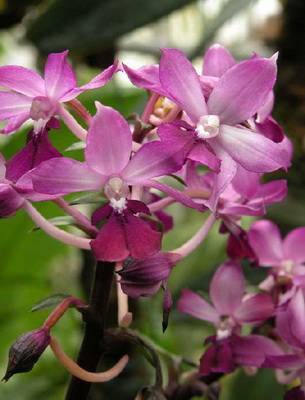
Calanthe
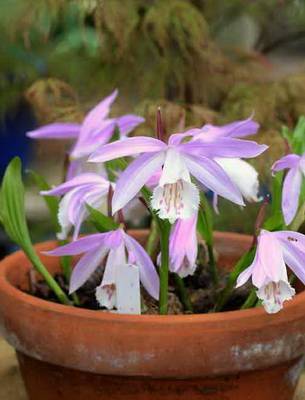
Pleione

Thunia

Eulophia
It is necessary to use fertilizers for the roots of orchids, in which the periods of biological dormancy are not so pronounced in the annual growth cycle, should be done according to different rules. Growing such plants using artificial supplementary lighting (this mainly concerns orchids native to the tropics of the Southern Hemisphere), regular feeding can be continued even in winter, especially if the plants continue to grow actively.
The age and quality of the substrate also matters when choosing a fertilizer for the growth of orchids, because microorganisms are constantly working inside it - fungi, bacteria, cyanobacteria. Fungi and bacteria process the organic matter of the substrate and mineral fertilizers into a form accessible to the roots and supply part of the nutrients to the roots of orchids.
Gradually, together with nutrients, toxic substances accumulate in the old substrate, in addition, organic matter processed by microorganisms prevents free access of air to the roots. The older the substrate, the less breathable it is and the more salts it contains.
With age, the substrate can accumulate so much toxic salts that, upon contact with them, the growing tips of the roots will begin to die off. Therefore, watering and fertilizing to stimulate the flowering of orchids, which have not been transplanted into another pot for a long time, should be less frequent than those freshly transplanted into a fresh substrate.
An orchid planted on a hungry organic substrate (for example, from the bark), on the contrary, is fighting for mineral nutrition with microorganisms, therefore it needs more intensive feeding, which, however, should be started only 2-3 weeks after transplanting and after being introduced into the substrate young roots.
When can I apply
The recipe will help the orchid in any difficult situation for the flower. For prophylaxis, the solution can be used during transition periods - in autumn and spring. If, after application, a deterioration in the general condition of the flower is noticed, take a break from use.
Pay attention! When color is lost, vitality leaves and growth slows down - the use is mandatory in conjunction with other means of combating the disease.
Despite a number of undoubted advantages of water with garlic, its use is not always useful for an orchid:
- Water is not used during the flowering period. Delicate buds may not withstand this treatment and dry out or burn out.
- A highly concentrated solution is capable of destroying newly formed young shoots, so the solution must be highly diluted.
- Immersion of the entire root system in a solution at any stage of plant development is dangerous, therefore, the roots are processed by other methods.
- Do not use a deteriorated solution in any case, such an effect can lead to rotting of the entire orchid.
When to use water
Many growers use garlic watering on an ongoing basis. Making a not too concentrated infusion, they use it instead of regular water for irrigation. With this choice of using the infusion, the plant should be carefully examined. If it's absolutely healthy, this way of leaving is perfectly acceptable. If the plant has damaged roots, the garlic can leave its own burns on them. The reason for this will be the increased concentration of juice in the soil for the orchid.
Prophylaxis
After a long winter, the exotic beauty can be fed for active growth and flowering. The optimal environmentally friendly remedy would be garlic infusion for orchids. It is used twice with an interval of 15 days; there must be regular watering between garlic waterings. The result will be visible after the first application of the garlic tincture:
- for 3-4 days the leaves become dense, shiny;
- a week later, new thick roots appear;
- flower stalks appear in two weeks.
As a preventive measure, such an infusion can be used at any time of the year, if the leaves of the plant become soft and look unhealthy.
Note! When the plant is sleeping, you do not need to fertilize it, there will be no benefit
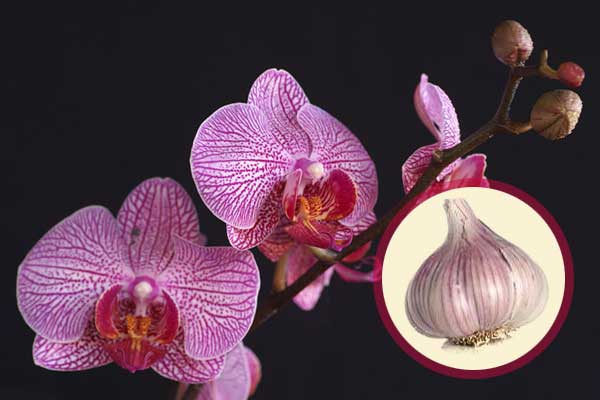
During flowering, water should be done with caution, as there is a risk of young buds falling off.
Treatment
If pests were found in the soil or at the base of the flower stem, they are treated until the signs of infection completely disappear. Moreover, not only watering of the plant is carried out, but also spraying of foliage. The pests will die and disappear from the soil after the third application of garlic water. It will perfectly neutralize the soil from bug larvae.
Important! When spraying the orchid, it is important not to get on the flowers and buds, because the solution leaves burns. During treatment, watering should be alternated with the usual, so as not to harm the plant.
During treatment, watering should be alternated with the usual, so as not to harm the plant.
Flower restoration
Orchids suffer from improper care, watering regime, temperature of maintenance. The painful condition of novice flower growers is found in the last stages, when the plant is in a semi-living state. It is possible to feed an orchid with garlic water as a medicine with the following signs of improper care:
- wilting of foliage;
- yellowing of the leaf plate in whole or in part;
- lack of new sheets;
- decay or drying of the roots;
- stopping the growth of the root system;
- lack of flowering.
During treatment, it is important not only to feed the plant, but also to restore all the necessary conditions for its full growth. The results of treatment are noticeable after the first watering, but sometimes full recovery takes up to three months
Soil change
During transplantation, the plant is examined and its damaged dry roots are cut. This procedure often deprives the orchid from 50 to 75% of the root processes. After such a "haircut", the orchid builds up the root system, not releasing new shoots of leaves and peduncles. The healing water speeds up this process.

Garlic promotes active growth of healthy roots, filling them with life and energy
How to make garlic watering infusion for orchids
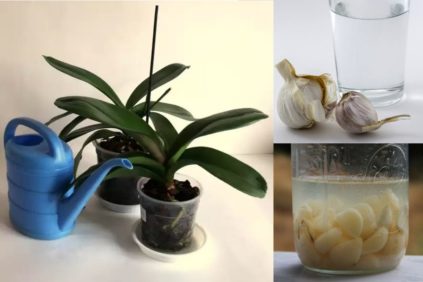 In order to prepare a homemade garlic solution, you will need:
In order to prepare a homemade garlic solution, you will need:
- 5-6 heads of garlic;
- garlic press;
- 1.5-2 liters of boiled water;
- scales;
- jar with a lid;
- small plate.
Procedure:
- Peel all the garlic and chop.
- Heat water, but do not bring to a boil.
- Put all the garlic in a jar and cover with water.
- Close the lid tightly.
- Place the solution in a warm, but not lit place for 5 days.
- After 5 days, transfer the solution to the refrigerator to avoid fermentation.
Some growers suggest adding one succinic acid tablet to the solution - it enhances the beneficial properties of garlic.
It is not enough to prepare a solution - it is necessary to properly organize watering and reduce the likelihood of trouble.
Advice! To make the watering process more efficient, you need to reduce the concentration of the solution. A 1 to 9 ratio of garlic to water is sufficient.
Direct watering is not always required, the use of fertilizers is necessary for both leaves and flowers:
- Immersion processing. In the absence of contraindications for using this method, completely immerse the orchid root system in a deep container with a solution and rinse. The actions must be careful not to damage the thin root system of the flower. Leave the flower in the solution for an hour, then rinse under a gentle pressure of water and place back in the pot with soil. Repeat the procedure after 2 weeks.
- Spray treatment. Place a not very concentrated solution in a spray bottle and apply to the leaves, carefully avoiding the flowers. Until completely absorbed, do not expose flowers to the open sun.
- Damage handling. Apply the solution to a cotton pad and apply for a few minutes to the wounds formed on the leaves and stems.
It is enough to water the plant as usual - 2-3 times a week. If garlic water is used for pest control, you can treat the flower in small portions every morning and evening.
Errors:
- Using a high concentration solution. Pure garlic kills useful substances in the composition of the substrate, so the concentration should be more careful.
- Convincing about the length of the shelf life. Even when stored for a long time in the refrigerator, microbes begin to multiply in the solution. Getting on the damaged areas of the orchid, they can lead to the development of diseases in flowers.
- Joint use with other drugs. Entering into a chemical reaction with various substances, the solution provokes damage to the plant without a protective layer. It is necessary to use different fertilizers in courses - one remedy for two weeks, another for two weeks.
How watering is carried out
There are no special conditions for watering phalaenopsis with garlic extract. The only thing to be said is that the non-root method and the root method can be used. If desired, you can lower the flowerpot into the solution, or you can spray the stem or leaves. Some also water the flowers, but as already mentioned, this should not be done unnecessarily, because all the buds immediately crumble.
During the dive, you need to make sure that the flowerpot does not float completely, it is enough for the liquid to cover two-thirds of the container. The roots will get wet anyway, so you shouldn't worry about this moment. The flower in garlic trays is left for at least 40 minutes, and a maximum for 4 hours. This is the time it takes for all the nutrients to be absorbed into the roots and soil.
After the manipulation, the flowerpot must be placed on a pallet and let it stand for 30-50 minutes so that all the excess liquid is glass. Then the flower can be removed to its usual place.
p> Foliar dressing involves spraying. This is done from a spray bottle. The procedure is carried out until the orchid is completely wet.
Precautionary measures
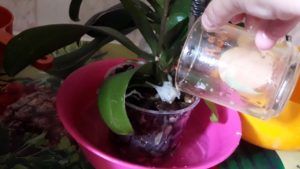 In what phases of plant life should the drug not be treated? In no case should the orchid be processed when it is at rest. Wait until its growth is activated and feel free to use succinic acid.
In what phases of plant life should the drug not be treated? In no case should the orchid be processed when it is at rest. Wait until its growth is activated and feel free to use succinic acid.
Avoid processing a flowering plant as well, it is best to postpone it until the last flower has faded and dries up.
What can the solution get into the axils of the leaves?
Drops of water flowing into the base of the leaf can cause rot not only of the leaf plate, but also those adjacent to it, and in the worst case, rotting of the neck of the orchid.
Personal security measures
Succinic acid is non-toxic, so there are no precautions when preparing a solution. It can even be cooked in kitchen utensils. In this case, it is worth giving preference to plastic, glass or ceramic containers.
Useful videos
Watch the video experiment on watering orchids with garlic and succinic acid:
And here you can see what changes have occurred to the orchid after the above watering procedure:
And this video is dedicated to another experiment with watering it with a solution of garlic and amber:
To grow orchids healthy, strong, actively developing, bright and long-lasting blooming, it is not necessary to purchase expensive and inaccessible drugs. Often the simplest and most primitive remedy has the most significant effect on the development of the plant and the elimination of existing problems.
Feeding orchids with garlic water: recipe, watering rules
Garlic contains a huge amount of nutrients and vitamins. It has antifungal, antiseptic properties, helps the orchid fight diseases. Watering orchids with garlic water is: effective feeding and disease prevention on plants. When transplanting, it helps the rapid adaptation of plants, stimulates rapid growth. Helps in the fight against pests, saturates plants with nutrients.
Indications for use
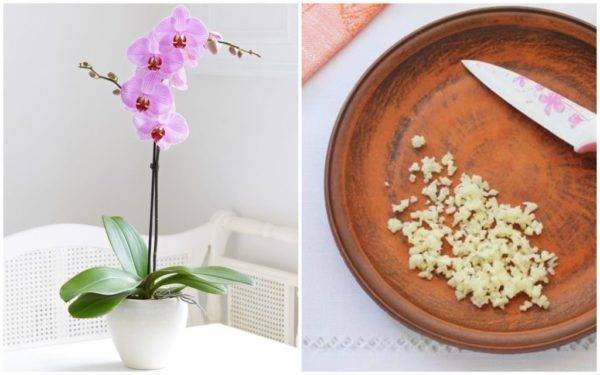
- Does not bloom.
- Poorly grows leaves and roots.
- Leaves turn yellow and wither.
- Signs of a fungal infection are visible.
- Small, unpleasant insect pests are bred in the pot.
Garlic is the best disinfectant that can help both people and plants. One clove contains a storehouse of beneficial acids, mineral salts, and antioxidants. It nourishes the plant with useful substances, which helps it get rid of all sorts of diseases, strengthen the flower and disinfect the soil.
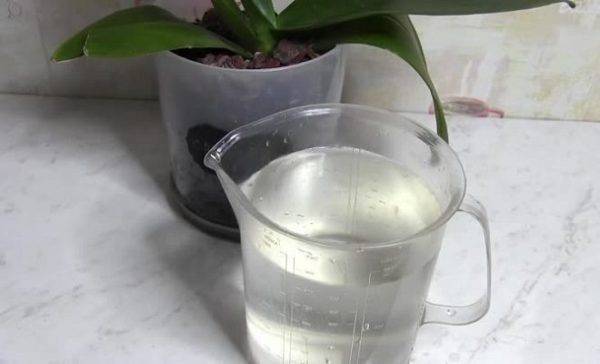
Do not use the infusion during flowering, more often 2 times a month, if the infusion has fermented or has not changed for more than 3 days. In no case should the dosage be exceeded, otherwise the high content of garlic can burn the plant. It is strictly forbidden to water the orchid only with garlic, this method is only suitable for the rehabilitation of a weak plant
Therefore, you should be careful and careful in your actions.
How to prepare and use garlic infusion for watering orchids
To prepare garlic infusion you will need:
- 170 grams of garlic;
- 1 liter of filtered or distilled water;
- 2 liter container with screw cap.
- Peel the slices and chop in a garlic bowl.
- Pour 1 liter of water into a jar (30-40 ° C).
- Place the chopped garlic in a jar and close the lid tightly.
The tool can be used in several ways: foliar and root method.
- Non-root method: spray the roots and stems of the plant (not flowers!) With a solution. It is better to use a spray bottle for this.
- Root method: dip the potted orchid into the prepared infusion. The flower can be in this solution from 40 minutes to 3 hours.
Garlic watering of orchids is carried out as the soil dries. But at the same time, you cannot water the plant only with garlic infusion, it also needs ordinary, clean water. Do not abuse this solution! If you water the flower more than 2-3 times a month, you will soon notice that the plant begins to die.This is because the excess garlic burns the orchid's root system.
Contraindications and errors
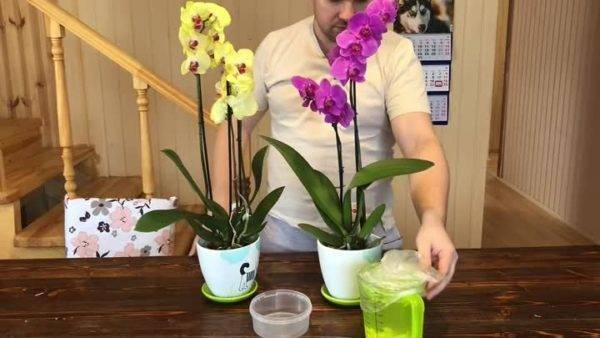
- spray infusion of flower stalks and buds;
- use only garlic water for irrigation, not alternating with clean water;
- water the orchid with a garlic solution more than 3 times a month;
- process the orchid during the dormant and flowering phase;
- use fermented infusion.
These rules must be followed and it will become for the orchid as an exceptional benefit!
Many growers, out of inexperience, using this solution, make many mistakes that adversely affect the life of the plant. In addition to using garlic, you must not forget about proper, constant care.
Lack or excess of lighting, violation of the permissible temperature, dryness or humidity of the air - all this must be observed and not try to "heal" the plant with garlic water alone. Do not forget about agricultural care, since the orchid does not tolerate bad soil. Orchid is a very whimsical plant, but it is very beautiful and, of course, it requires special care.


